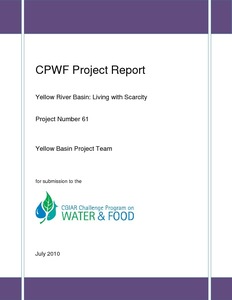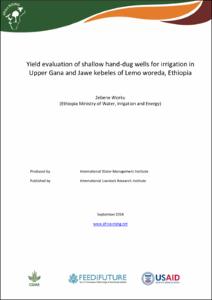Watershed moments: a photographic anthology celebrating 30 years of research for a water-secure world (1985–2015 and beyond)
Working together for impact
Despite challenges in many river
basins, overall the planet has
enough water to meet the full range
of peoples’ and ecosystems’ needs
for the foreseeable future, but
equity will only be achieved through
judicious and creative management.
World Water Assessment Programme Sri Lanka case study, Ruhuna basins: proceedings of a Workshop held at Koggala Beach Hotel, Sri Lanka, 7-9 April 2002
The Case Study Workshop was organized with the objective of obtaining the necessary input the experts on different subject areas of water resources, subject those views and discussion among the stakeholder agencies, and synthesize the information to a report on the case study. The outcome of the Workshop would eventually transform into the contribution of Sri Lanka to the forst WWDR.
World water productivity: current situation and future options
Yellow River Basin: Living with scarcity
The Yellow River Basin (YRB) Focal Project set out to study water poverty, water
availability and access, water productivity, and water and related institutions in the
Yellow River basin to develop and rank a series of high-priority interventions aimed at
increasing water and food security for the poor, while maintaining environmental
sustainability. The YBFP identified complex relations between water and poverty in the
YRB; identified streamflow declines in the basin despite predicted higher rainfall;
Yield and water use efficiency of furrow irrigated potato under regulated deficit irrigation, Atsibi-Wemberta, North Ethiopia
The pressure on availability of water in Tigray regional state is likely to increase as the requirement for food production in couple with rapidly growing of the population is at increasing rate. Hence, improving water productivity using regulated deficit irrigation is important to reduce the water consumption while minimizing adverse effects on the crop yield. This study was conducted in the eastern zone of Tigray regional state, Atsibi Womberta district.
Yield evaluation of shallow hand-dug wells for irrigation in Upper Gana and Jawe kebeles of Lemo woreda, Ethiopia
Yield gaps in oil palm: A quantitative review of contributing factors
Oil palm, currently the world’s main vegetable oil crop, is characterised by a large productivity and a long life span (?25 years). Peak oil yields of 12 t ha?1 yr?1 have been achieved in small plantations, and maximum theoretical yields as calculated with simulation models are 18.5 t oil ha?1 yr?1, yet average productivity worldwide has stagnated around 3 t oil ha?1 yr?1. Considering the threat of expansion into valuable rainforests, it is important that the factors underlying these existing yield gaps are understood and, where feasible, addressed.
The rising challenge of water resources management at the urban fringes - evidence from Ferghana district of Uzbekistan [Abstract only]
With the global expansion of urban areas, competition over both land and water resources is steadily increasing, especially within developing countries(FAO 2012; Kuslu 2007; CER 2009). The expansion of urban areas into agricultural areas, such as in Uzbekistan, has created competition for water between farmers and non-farmers (FAO 2002, 2005). Subsequent growth of urban and peri-urban areas envisages new and expanded demands for water resources, entailing both reproductive and productive uses especially by the poor (Drechsel et al. 2006; van Koppen et al. 2006).






